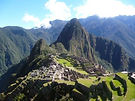PERU INFO
Home > About Peru > Fauna > Typical animals
About Peru
Typical animals of Peru
With three very distinct regions, the coastal desert, the Andes mountains, the Jungle and its large variety of climates, including 28 of the 32 world climates, Peru has some of the world's greatest biodiversity in the world. For example Peru has 1,730 species of birds representing 20% of the planet species and scientists estimate that Peru has 4,200 species of butterflies, impressive compared to 441 in Europe and 679 in North America.
The animals that can be seen in Peru:
Most commun animals
The South American camelids
From the same family as camels and dromedaries, there are two domesticated species, the llama and the alpaca, and two wild species, the vicuña and the guanaco. South American camelids have a tendency to spit when disturbed, but all do not, depends on their character or mood. So, be careful approaching very close, if the animal looks us in the eyes, lay its ears back and start grimacing, warns us!
Llama
Lama Glama Linnaeus
It is the largest of the South American camelids, full-size llama is 1.30 to 1.80 m (5.5 to 6 ft) tall at the top of the head and can weigh 130 kg to 200 kg (280 to 450 lb).
Used as a pack animal, the wool is not of very high quality. Its meat is consumed in Bolivia and in Peru only dried, called "charki".
Alpaca
Vicugna Pacos Linnaeus
Smaller than the llama, full-size alpaca is 1 m (40 in) at the withers and weighs 70 kg (150 lb) maximum. Alpaca fiber is of very high quality and this animal has the lowest level of cholesterol of any meat.
Peru is the largest breeder of alpacas. There are two species, the most common is the huacaya with a dense and fluffy wool, while the suri has a long and wavy fleece.
Not so common animals
Vicuña
Vicugna Vicugna Molina
Visible in the reserves of Pampas Galeras (100 km / 60 mi northeast of Nasca) and Salinas y Aguadas Blancas north of Arequipa at 4,000 m (13,000 ft) above sea level. It is the smallest of camelids, 90 cm (35 in) at the withers and weighs up to 40 kg (90 lb). Vicuña is easily recognized thanks to its wooly coat of cinnamon colour, white throat and chest, graceful with big eyes and long eyelashes.
Guanaco
Lama Guanicoe Mulle
As the vicuña, guanaco is a wild animal, but much larger, 1.10 m (43 in) - 120 kg (270 lb), more similar to the llama, a parent specie. The wool is dense, short, reddish brown with a grey face and small straight ears.
Andean condor
Vultur Gryphus
It is a bird family Cathartidae, an American vultures and one can be seen its majestic flight in the Colca and Cotahuasi canyons (Arequipa).
The condor is a scavenger and is the world's largest flying bird with more than 1 m (3.30 ft) tall, a wingspan of 3.80 m (12 ft) and reaching a weight of 11 to 15 kg (24 to 33 lb).
Juveniles have a brown brown until 2 years old. The adult plumage is black with white feathers surrounding the neck and parts of the wings. In the male, the head is crowned with a dark red comb.
The condor lives in inaccessible rock ledges in the Andes. it flaps its wings very rarely, relying on thermals to stay aloft, can reach 7,000 meters (23,000 ft) and flight hundreds of kilometers.
Condor is known to be a sociable and faithful animal, can live up to 90 years. The female deposits only one egg every two years and the species is in danger of extinction.
The condor eat more than 1 kg of meat feeding mainly on carrion.
Legends and customs
Popular belief has it that the condor can carry a small animal and even a child that is completely wrong. Its own weight hardly allows soar, therefore it is impossible to carry an additional load. Besides the hind toe is slightly developed and the feet are of little use as organs of prehension.
Peruvian hairless dog
It is usually found in the Peruvian coast.
The Peruvian hairless dog is a breed of dog with its origins in Peruvian pre-Inca cultures, represented on ceramics of different civilizations, the oldest dating from 300 BC.
In Inca times it was called the Allqu and was reserved for the nobility. Today this dog is scarce and the Peruvian Congress declared it as heritage of the nation in 2001.
Its skin is smooth, elastic and warm to the touch for his lack of hair. The color, uniform or with pink spots can be black, gray (the most common) or brown (light or dark). It can be completely hairless or may have short hair on top of its head, on the tip of its tail and on its feet.
Exists three sizes:
Small - 25-40 cm (10-16 in) weight 4-8 kg (8-18 lb)
Medium - 40-50 cm (16-20 in) weight 8-12 kg (18-26 lb)
Large - 50-65 cm (20-26 in) weight 12-25 kg (26-55 lb)
Vizcacha
Lagidium Peruanum
Lives in the Andes and one can be see it in the Colca Canyon and Macchu Picchu. It is a small rodent in the same family as the Chinchilla (Chunchilla Lanigera) and is endemic to Peru (only found in this country).
It is usually gray in color with a bushy and long tail. They are often immobile and sunning on the rocks.
Rare animals
Puma
Puma Concolor
The cougar or puma is a large felid native to the Americas and was part of the Andean trilogy, the 3 worlds (heaven, earth and subsoil) represented respectively by the 3 sacred animals (the condor, puma and the snake).
Adult stand about 60 to 90 cm (24 to 35 in) tall at the shoulders around 2.40 m (7.9 ft) long nose-to-tail, weigh 50 to 100 kg (115 to 220 lb). Predator, the cougar will eat any animal it can catch, from insects to large animals like deer and rarely reaches more than 13/14 years.
The gougar almost disappeared from the Andean highlands to take refuge on the eastern slope, between Andes Amazon jungle.
spectacled bear
Tremarctos Ornatus
The spectacled bear or Andean bear lives in the high jungle boundary between the Andes and the Amazon rainforest between 500 and 2.700 m (1.600 to 9.000 ft), mainly in Peru. Is a medium-sized bear, with less than two meters (80 in) tall, can weigh from 100 to 200 kg (220 to 440 lb), its fur is blackish in color and its name usually comes from white markings around the eyes.
Anaconda
Eunectes Murinus
It is a constrictor snake family genus of boas found in tropical South America.
Anaconda is the largest snake in the world, reaching up to 10 m (33 ft) long, can weigh 250 kg (550 lb) and 40 cm (16 in) in diameter, but generally measured 5-7 m (16-23 ft) weighing 50-100 kg (110-220 lb). It has a dark green color lighter on the belly with black and beige spots on the flanks and yellow and black patterns on the tip of the tail.
Anaconda lives in trees where it let slip from the branches to attack its prey, and also in rivers or ponds where the snake may surprise other animal coming to get water.
It is a constrictor, means that winds around its prey to drown it. Despite its enormous size, anaconda has a surprisingly rapidity, leaving no chance the animal to escape. Tests performed with an anaconda of 6 m (20 ft) and 40 kg (90 lb) attacking a turkey provided with sensors. The pressure exerted by the snake was calculated at 6.5 kg / cm2 (93 Psi), equivalent to 4 tons (8.800 lb) of pressure.
The anaconda swallows its prey with its separate jaws, allowing to eat large size animals.
Their favorite prey are capybaras (the largest rodent in the world - 80 kg), tapirs, peccaries, deer, alligators and jaguars. Anaconda among the 10 most powerful animal in the world is considered as zoologists.
Digestion can last several weeks, so it is completely harmless and almost numb during this time.
Jaguar
Panthera Onca
The jaguar or otorongo is the largest cat in America, reaching 2.70 m (9 ft) from head to tail and weighing many times more than 100 kg (220 lb).
Like a leopard, his behavior is closer to the tiger. Such as this, like swimming and are solitary hunters.
The jaguar has the strongest powerful bite of felines, it pierces directly through the temporal bones of the skull with its canine teeth, piercing the brain and can pierce the shell of a huge turtle. Jaguar Hunts usually large prey like deer, peccaries, tapirs, crocodiles and large snakes like the anaconda.
Cock-of-the-rock
Rupicola Peruviana
The gallito de las rocas or Tunki in Quechua, is found in the high jungle of the Amazon rainforest, on the eastern slope of the Andes and is the national bird of Peru. He lives between 1,000 and 2,500 m (3,300 - 8,000 ft) above sea level on the cliffs near a river, always in inaccessible places.
Medium in size, about 30 cm (12 in), the male is bright orange or red colors with a very prominent fan-shaped crest, wings and tail are black. The female is overall brownish, which allows it merges with the rocks.
Piraña
Pygocentrus nattereri
Small fish of the Amazon rainforest, is normally 15 to 25 cm (6 to 10 in) long, rarely more than 30 cm (12 in). Contrary to popular belief, piranhas rarely attack humans, besides Indians bathe in rivers without problems and its flesh is delicious. However, take care of your fingers when removing the fish hook and not bathe with a bloody wound!
Pink dolphin
Inia Geoffrensis
Also called Amazon river dolphin, is the largest freshwater river dolphin, can range up to 2.50 m (8.2 ft) in lengh and weigh up to 100 kg (220 lb). Dark gray at birth, rinsed in adolescence and adult takes its pink color, males have a more intense color.
The dolphin seducer
In traditional Amazon floklore, the pink dolphin becomes at night a handsome young man who seduces girls. This myth is used to justify out of wedlock pregnancies and single mothers.
Peru




